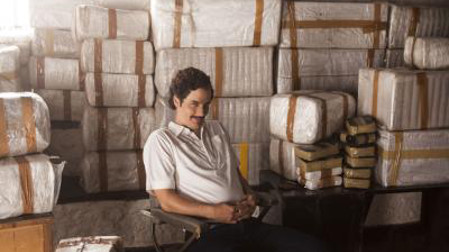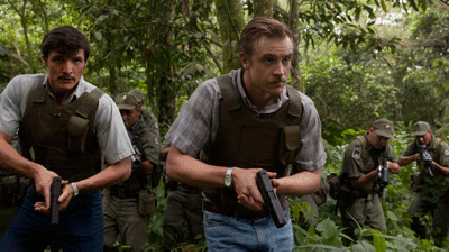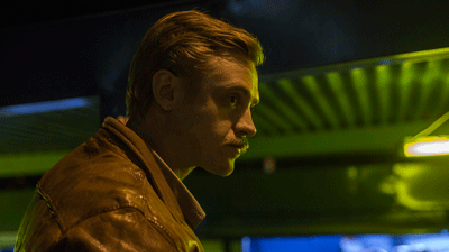Shooting Netflix's 'Narcos'

Wagner Moura as Pablo Escobar. Photo by Daniel Daza/Netflix
LOS ANGELES—Created by Chris Brancato, Carlo Bernard and Doug Miro, the Netflix original series Narcos from Gaumont International Television premiered on the streaming service on Aug. 28, and was recently renewed for a second season.
Inspired by real-life events, the series' first season chronicles the bloody history and rise and fall of some of the world's most infamous cocaine drug cartels in the face of countermeasures by both ruthless competitors and law enforcement.
"We wanted to be, and to look, authentic, and to have that [documentary] feel, which is really hard to get in a studio," says Brazilian director Jose Padilha, who directed the pilot and second episode. "We shot almost everything on location in Colombia."
Padilha, who has produced documentaries as well as feature films, says he tried to incorporate his knowledge of both filmmaking genres into the concept and production of Narcos—including the use of a voiceover narrator: American DEA agent Steve Murphy, who's in pursuit of Pablo Escobar and his network of operations.
"We wanted to have a series that would work in two different worlds—that would be interesting for an American audience and a Latin American audience," Padilha explains. "And the way to do it was to tell the DEA story."
Lula Carvalho, who served as director of photography on all 10 episodes, opted for RED EPIC Dragon cameras and Zeiss Ultra Prime lenses shooting 5K. (Netflix typically requires at least 4K for all its new content.)

Pedro Pascal as Javier Peña and Boyd Holbrook as Steve Murphy. Photo by Daniel Daza/Netflix
"We approached a very realistic mood," Carvalho says. "It was important to play with the colors and elements that would help establish the 1980s and the narco culture mood. For the Miami segments, we used a Black Pro-Mist filter to differentiate from the Colombia look and to give us a softened reality compared to the one in Colombia. Also, we wanted to differentiate Colombia with a very colorful 'South American' feeling, which is more tropical and harsher than Miami."
Carvalho says the biggest challenge was shooting everything on location—not having a stage to work with. "The solution was to be quick and efficient, and nearly always have a second unit for shooting in parallel."
Carvalho and Padilha used camera stabilizers sparingly. "We did shoot several aerials using different kinds of mounts," Padilha notes. "Lots of dolly shots, too, as well as a few cranes. All in all, we were going for that documentary feel, and with virtually no VFX. We also tried to use a lot of panning shots. I directed the first two episodes trying to have an 'active camera'—a camera that would allow for voiceover and would get you into the action at the same time," Padilha says.
"The intricacies of this story haven't been explored," adds writer and executive producer Brancato. "The co-responsibility of the United States for the problem hasn't been explored. We're giving the viewer a distance by putting this back in time, but we're reflecting on the absurdity of certain aspects of the war on drugs. We're also reflecting on some aspects of the success of the war on drugs, and we're making some allusions to the United States' war on terror."
"What was important to me is that it told the story honestly," adds executive producer Eric Newman, "that the stakes were apparent and clear and that it still relates to the world today."

Boyd Holbrook. Photo by Daniel Daza/Netflix
Company 3 Enhances the Raw Look of Narcos
The unique visuals of the show offered inspiring opportunities for Company 3's Siggy Ferstl, who handles color grading duties for Narcos under the supervision of Stefan Sonnenfeld.
"A lot of it's about what we don't do rather than what we do," Ferstl explains. "We deliberately give it a slightly raw look, which helps give the show its period feel. Back in the '70s, movies were generally not as polished as they are now—everything was photochemical; there were no power windows or anything like that. A lot of the work on Narcos is about leaving certain things, or even enhancing them, and not trying to 'correct' them.
"It's beautifully shot," Ferstl continues. "We might have a shot with a strong green feeling [in a fluorescent-lit room] and then the shot continues into a very orange, tungsten-lit space. We don't hide any of the differences. We might even enhance them. Or there might be some extreme falloff from a brightly lit room into deep shadow where an actor's face is very dark. The natural instinct is to brighten up the face and the eyes, but instead we keep it natural.
"It's a different way of working and I really enjoy it," Ferstl concludes.
Get the TV Tech Newsletter
The professional video industry's #1 source for news, trends and product and tech information. Sign up below.
